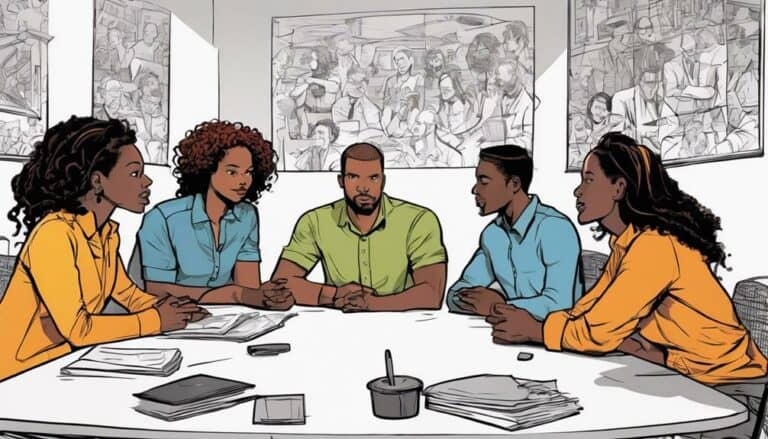Just as a conductor guides an orchestra to create harmonious melodies, a leader can orchestrate collaboration and idea-sharing among team members to enhance communication.
By implementing strategic approaches such as fostering a culture of openness and inclusivity, a leader can pave the way for a more cohesive and innovative team dynamic.
But how can these principles be put into action effectively to truly elevate the team's performance and outcomes? Let's explore some practical strategies that leaders can employ to encourage collaboration and idea-sharing among team members in order to enhance communication and drive success.
Key Takeaways
- Foster trust and rapport through active listening and appreciation.
- Utilize open-ended questions to stimulate critical thinking and diverse perspectives.
- Establish a feedback loop to gather valuable insights and showcase impact.
- Recognize and reward innovative ideas to boost morale and motivation.
Building Trust and Rapport
To foster collaboration among team members, establishing trust and rapport is pivotal for creating a positive and productive working environment. Building trust within a team is essential for effective communication, idea sharing, and ultimately, successful collaboration.
By actively listening to team members and providing constructive feedback, you can show genuine interest in their perspectives, which encourages open communication. Acknowledging their efforts, appreciating strengths, and celebrating achievements not only boost morale but also help in building relationships and fostering trust among team members.
It's essential to create a positive and respectful atmosphere where team members feel safe to share their ideas without fear of criticism or judgment. Avoiding negative behaviors like ridicule or harsh criticism maintains a trusting environment that's conducive to idea sharing. By listening actively, providing constructive feedback, and encouraging open communication, you can lay the foundation for a cohesive team with a positive atmosphere that thrives on collaboration.
Using Open-Ended Questions
Establishing a culture of using open-ended questions within your team can greatly enhance critical thinking, foster innovation, and deepen communication dynamics.
Open-ended questions stimulate critical thinking and problem-solving skills by prompting team members to think beyond simple yes or no answers, encouraging them to explore ideas more deeply. They invite diverse perspectives, leading to a broader range of innovative ideas that may not have surfaced otherwise.
By actively listening to the responses generated by open-ended questions, team members demonstrate mutual respect for each other's opinions and contributions. This practice makes team members feel valued and appreciated, creating an environment where sharing thoughts and ideas is encouraged.
As a result, using open-ended questions can lead to richer discussions, deeper understanding, and stronger collaboration among team members. Embracing open-ended questions as a communication tool can greatly enhance the overall effectiveness and productivity of your team.
Establishing a Feedback Loop
Setting clear goals and expectations for ideas within your team is essential for initiating a robust feedback loop that enhances communication improvement. By establishing a feedback loop, you create a structured process where roles and responsibilities are clearly defined for idea implementation. This structure guarantees that feedback is gathered consistently, allowing you to measure the effectiveness of ideas accurately.
Soliciting feedback from stakeholders and customers is vital as it provides valuable insights for refining communication strategies. Motivating team members by showcasing the impact of their ideas not only closes the feedback loop but also encourages continuous improvement within the team.
Recognizing and Rewarding Ideas
Boost team morale and motivation by recognizing and rewarding innovative ideas within your team. Acknowledging and celebrating innovative contributions not only motivates the individual whose idea is being recognized but also encourages more team members to share their ideas. Offering public praise for inventive solutions can substantially reinforce a culture of idea-sharing within your team.
Implementing rewards for successful ideas is another effective way to foster a positive environment for collaboration and teamwork. By recognizing team members for their creativity and contributions, you not only enhance communication within the team but also create a sense of appreciation and value among team members.
Leading by Example
Demonstrating a commitment to fostering collaboration and idea-sharing among team members is fundamental to establishing a culture of innovation and teamwork within your organization. To lead by example and encourage team collaboration effectively, consider the following strategies:
- Build Trust: Establish trust within your team by being transparent, reliable, and demonstrating integrity.
- Let Your Team Know One Another: Encourage team members to share their backgrounds, skills, and interests to foster a sense of community.
- Explain Your Perspective: Clearly communicate your thoughts, decisions, and expectations to provide insight into your leadership approach.
- Help Your Team Feel Comfortable: Create a supportive environment where team members feel safe to express their opinions and ideas.
- Model Collaborative Behavior: Demonstrate active listening, open communication, and a willingness to collaborate with others, setting a positive example for your team to follow.
Conclusion
To summarize, by fostering an environment where collaboration and idea-sharing are valued, a leader can enhance communication within a team. Building trust, using open-ended questions, establishing a feedback loop, and recognizing ideas are key strategies to promote a culture of openness and inclusivity.
Remember, leading by example is vital in setting the tone for effective teamwork. So, keep encouraging diverse perspectives and celebrating innovative solutions to keep the communication flowing smoothly.

